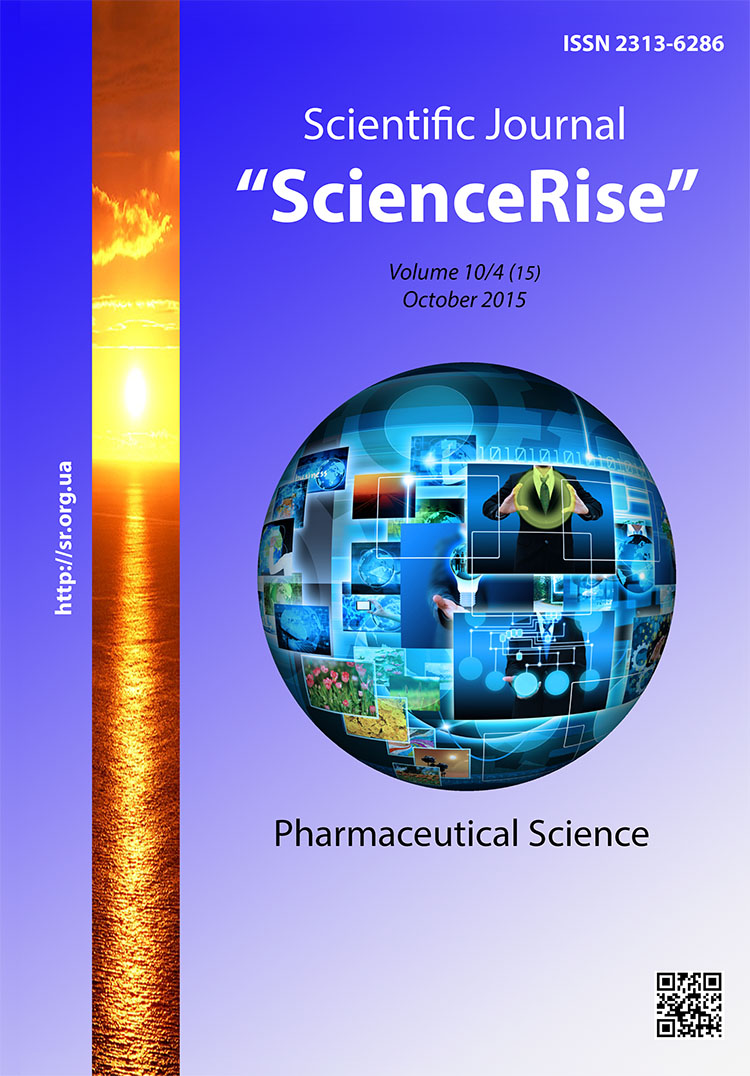Research of polysaccharide complexes from asteraceae family plants
DOI:
https://doi.org/10.15587/2313-8416.2015.52002Keywords:
polysaccharide complexes, water-soluble polysaccharides, pectin compounds, monosaccharide composition, Asteraceae familyAbstract
Aim of research. Depth study of polysaccharides in some little-known plant species of Asteraceae family is pressing question, considering that polysaccharides are important biologically active compounds widely used in pharmaceutical and medical practice as remedies and preventive medications. The aim of research was to determinate both quantitative content and monomeric composition of polysaccharide complexes from Asteraceae family plant species – Tagetes genus, Arnica genus, and Bellis genus.
Materials and methods. Determination of polysaccharides was carried out by the precipitation reaction, using 96 % ethyl alcohol P and Fehling's solution after acid hydrolysis; quantitative content of this group of compounds was determined by gravimetric analysis. On purpose to identify the monomeric composition hydrolysis under sulfuric acid conditions was conducted. Qualitative monomeric composition of polysaccharides after hydrolysis was carried out by paper chromatography method in n-Butanol – Pyridine – Distilled water P (6:4:3) system along with saccharides reference samples.
Results. Polysaccharide complexes from Tagetes erecta, Tagetes patula, Tagetes tenuifolia, Arnica montana, Arnica foliosa, wild and cultivated Bellis perennis herbs were studied. Water-soluble polysaccharides and pectin fractions were isolated from studied objects; their quantitative content and monomeric composition were determined.
Conclusion. The highest amount of water-soluble polysaccharides was found in cultivated Bellis perennis herb (10,13 %), the highest amount of pectin compounds – in Tagetes tenuifolia herb (13,62 %); the lowest amount of water-soluble polysaccharides and pectin compounds was found in Arnica montana herb (4,61 %) and Tagetes patula herb (3,62 %), respectively. It was found that polysaccharide complexes from all studied species include glucose and arabinose
References
Kaisheva, N., Vasilenko, Yu. (2002). Investigation of anabolic action of polysaccharides in lead intoxication. Actual problems of creating new drugs of natural origin’: abstracts of the 6th symposium, 398.
Kyslychenko, V., Tkachenko, O., Borysenko, O. (2000). Investigation of the effect of water extract and polysaccharide complexes of the bark of stems of the genus Ribes L. representatives on immunological parameters. J. Pharm. Journ., 6, 85–86.
Gergel, Ye., Konovalova, O., Djan, T., Vasjuk, Ye. (2011). Investigation of carbohydrates content in cherry silverberry (Elaeagnus multiflora L.) and in wild olive (Elaeagnus angustifolia L.) fruits. J. Pharm. Journ., 6, 96–98.
Berezina, V., Povydysh, M., Teslov, L., Budantsev, A. (2003). Content and composition of the sum of polysaccharide complexes in aerial parts of Lamium album L. and Galeobdolon luteum Huds. J. Plant Sources, 1, 69–76.
Andreev, P. (2004) The application of native modified starches in chemical and pharmaceutical industry. Chem. And Pharm. J., 38 (8), 37–41.
Konovalova, O., Mitchenko, F., Shuraeva, T. (2008). Biologically active substances of medicinal plants. Kyiv: “Kyiv University” Publishers, 280.
Marchyshyn, S., Berdey, T., Kozachok, S., Demydyak, O. (2013). Determination of flavonoids and hydroxycinnamic acids in the herb of Tagetes erecta L., Tagetes patula L. and Tagetes tenuifolia Cav. by HPLC. J. Med. and Scein. in Siberia, 6. Available at: http://www.ngmu.ru/cozo/mos/article/text_full.php?id=1205
Dakhym, I., Marchyshyn, S. (2014). Chemical composition of the common daisy herb. J. Achiev. of Clin. and Experim. Med., 1 (20), 35–38.
Kryshtanova, N., Safonova, M., Bolotova, V. et. al. (2005). Perspectives of the application of polysaccharides from plants as medicinal and preventive drugs. J. News of VSU: Chemistry. Biology. Pharmacy, 1, 212–221.
Abudeikh, Z. (2011). Investigation of qualitative and quantitative polysaccharides content in Chamaenerion angustifolium in different vegetation phases and in various organs. J. Phytotherapy, 3, 66–68.
Korzh, A., Guriev, A., Belousov, M. et. al. (2011). Monomer content of polysaccharides complex of marshmallow leaves. J. Bull. of Siberian Med., 5, 62–65.
Sushchuk, N., Kyslychenko, V., Kuznetsova, V. (2011). Investigation of polysaccharide complexes and organic acids of blackcurrant leaves and stems. Ukr. Med. Almanakh, 14 (6), 188–190.
Solodovnichenko, N., Zhuravlev, M., Kovalov, V. (2001). Medicinal plant material and phytomedicines: manual in Pharmacognosy with Basics of Biochemistry of Medicinal Plants. Kharkiv: Golden Pages, 406.
Gunter, E. A. (2001) Cell cultures of nonconventional plants as polysaccharide producers. J. Chemistry and computational simulation, 2 (5), 11–12.
Burceva, O., Terninko, I. (2010). Investigation of polysaccharide content of Avena sativa L. J. News of Pharm., 2 (62), 46–48.
State Pharmacopoeia of Ukraine (2009). 1st ed. Kharkiv: Ukrainian scientific pharmacopoeial center of medicines quality, 280.
Kalushka, O., Marchyshyn, S. (2009). Polysaccharide complex of aerial and subterranean organs of cough grass (AGROPYRON REPENS (L.). J. Pharm. Rev., 3, 22–24.
Downloads
Published
Issue
Section
License
Copyright (c) 2015 Світлана Михайлівна Марчишин, Ольга Лютославівна Демидяк, Ірина Степанівна Дахим, Тетяна Степанівна Бердей, Галина Романівна Козир

This work is licensed under a Creative Commons Attribution 4.0 International License.
Our journal abides by the Creative Commons CC BY copyright rights and permissions for open access journals.
Authors, who are published in this journal, agree to the following conditions:
1. The authors reserve the right to authorship of the work and pass the first publication right of this work to the journal under the terms of a Creative Commons CC BY, which allows others to freely distribute the published research with the obligatory reference to the authors of the original work and the first publication of the work in this journal.
2. The authors have the right to conclude separate supplement agreements that relate to non-exclusive work distribution in the form in which it has been published by the journal (for example, to upload the work to the online storage of the journal or publish it as part of a monograph), provided that the reference to the first publication of the work in this journal is included.

